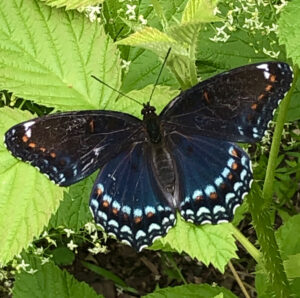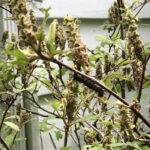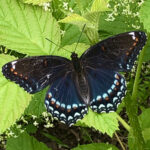 Though both moths and butterflies are classified as Lepidoptera and are often confused with one another, there are several anatomical ways to tell them apart. Their antennae, wings, pupae, and eyes are different, though it might take an advanced degree or microscope to notice the minuscule distinctions. Over the last few months, I’ve been developing a much easier, if less scientific, method of identification: moths (especially in their caterpillar stage) are destructive and impossible to get rid of; butterflies are harmless, beautiful, and all too elusive. Almost everyone I know in the Berkshires has been hit by the gypsy moth infestation this year. They denuded our majestic oak tree in less than week, trashed our fothergilla and witch hazel, and laid waste to the rose bushes and ferns.
Though both moths and butterflies are classified as Lepidoptera and are often confused with one another, there are several anatomical ways to tell them apart. Their antennae, wings, pupae, and eyes are different, though it might take an advanced degree or microscope to notice the minuscule distinctions. Over the last few months, I’ve been developing a much easier, if less scientific, method of identification: moths (especially in their caterpillar stage) are destructive and impossible to get rid of; butterflies are harmless, beautiful, and all too elusive. Almost everyone I know in the Berkshires has been hit by the gypsy moth infestation this year. They denuded our majestic oak tree in less than week, trashed our fothergilla and witch hazel, and laid waste to the rose bushes and ferns.
On the other hand, the garden is starting to fill with butterflies. I saw a Monarch floating above the wildflower field a few days ago where I’ve finally managed to introduce some milkweed. That’s a red-spotted purple admiral resting on our raspberry bush in the photo above.
The poem by Elizabeth Bishop below is not about an actual moth. It’s a flight of surreal fancy inspired by a typo she noticed in the New York Times. Yet the images (“his shadow dragging like a photographer’s cloth” and his eyes “all dark pupil, an entire night itself, whose haired horizon tightens as he stares back”) seem to me brilliantly moth-like. Written very early in her career when she was just out of college, it’s as eerie and strangely compelling as a good horror movie.
The Man-Moth
By Elizabeth Bishop
Man-Moth: Newspaper misprint for “mammoth”
Here, above,
cracks in the buldings are filled with battered moonlight.
The whole shadow of Man is only as big as his hat.
It lies at his feet like a circle for a doll to stand on,
and he makes an inverted pin, the point magnetized to the moon.
He does not see the moon; he observes only her vast properties,
feeling the queer light on his hands, neither warm nor cold,
of a temperature impossible to records in thermometers.
But when the Man-Moth
pays his rare, although occasional, visits to the surface,
the moon looks rather different to him. He emerges
from an opening under the edge of one of the sidewalks
and nervously begins to scale the faces of the buildings.
He thinks the moon is a small hole at the top of the sky,
proving the sky quite useless for protection.
He trembles, but must investigate as high as he can climb.
Up the façades,
his shadow dragging like a photographer’s cloth behind him
he climbs fearfully, thinking that this time he will manage
to push his small head through that round clean opening
and be forced through, as from a tube, in black scrolls on the light.
(Man, standing below him, has no such illusions.)
But what the Man-Moth fears most he must do, although
he fails, of course, and falls back scared but quite unhurt.
Then he returns
to the pale subways of cement he calls his home. He flits,
he flutters, and cannot get aboard the silent trains
fast enough to suit him. The doors close swiftly.
The Man-Moth always seats himself facing the wrong way
and the train starts at once at its full, terrible speed,
without a shift in gears or a gradation of any sort.
He cannot tell the rate at which he travels backwards.
Each night he must
be carried through artificial tunnels and dream recurrent dreams.
Just as the ties recur beneath his train, these underlie
his rushing brain. He does not dare look out the window,
for the third rail, the unbroken draught of poison,
runs there beside him. He regards it as a disease
he has inherited the susceptibility to. He has to keep
his hands in his pockets, as others must wear mufflers.
If you catch him,
hold up a flashlight to his eye. It’s all dark pupil,
an entire night itself, whose haired horizon tightens
as he stares back, and closes up the eye. Then from the lids
one tear, his only possession, like the bee’s sting, slips.
Slyly he palms it, and if you’re not paying attention
he’ll swallow it. However, if you watch, he’ll hand it over,
cool as from underground springs and pure enough to drink.




Thanks, great post.
Thanks, as always, Phyllis!
I have been noticing a lot of commas lately. The butterfly is named that for the shape of its wing, and there is a cousin named the question mark. It is lovely to see them gather around puddles of rain.
Thanks for this, Patty. I’ll keep my eye out for commas and question marks in the Berkshires. I’d love to discover a semicolon.
Loved this post, Liza. And I’m reminded of a time when I was an assistant teacher in a Montessori Pre-Primary class (3 – 5 yr olds). Not untypical, we had 2 siblings in the class, one 3, one 5. One day the youngest came screaming in from the porch saying his brother had identified a “monster” butterfly out there. This was a true 3 yr old meltdown. On further investigation, we found his brother had meant “Monarch” butterfly.
What a wonderful story, Carole! I wish there were a lot more “monsters” like that in the world.